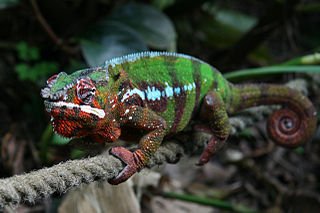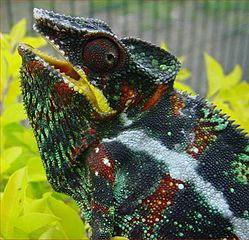Chameleons are spectacular creatures to care for, but they are almost “too interesting” for their own good. Drawn by their beauty and unique-to-bizarre characteristics, many rush into chameleon care without proper preparation. None are suitable for beginners, but if asked to recommend a large, colorful species to an experienced keeper, I would choose the majestic Panther Chameleon, Furcifer pardalis. While not as hardy as the Veiled Chameleon, Chamaeleo calyptratus, the Panther is adapted to environmental conditions that fluctuate wildly, and this seems assist its adjustment to captivity. It is also an excellent study subject…recent studies have revealed new insights into the relationship between chameleon basking behavior and diet (please see below).
I’ve worked with many chameleon species in zoos, and can attest to the difficulties involved even when one has sufficient space and supplies. Please read this article and those linked under “Further Reading” carefully, and post any questions below.
Description
The Panther Chameleon is one of the largest of the 198 described species. Males may reach 22 inches in length; females top out at 12-13 inches.
Male Panther Chameleons stand out for both the intensity and variation of their colors. Animals living in close but distinct habitats can easily be mistaken for different species. At least 21 unique “types” of Panther Chameleon have been proposed, each linked to a specific region.
Animals originating from Nosy Be (a small island off northwestern Madagascar) are very popular in the pet trade. Ranging from brilliant turquoise through various shades of bright bluish-green, male Nosy Be Panthers are simply gorgeous. An assortment of other colors, ranging from light blue with red stripes to dark green, may be seen in other populations. Some can change to pure yellow or burnt-orange, and the eye turrets may flash green, orange, red and other colors.
Range
The eastern and northwestern coasts of Madagascar; Reunion and other nearby islands.
Habitat
In contrast to most chameleons, Panthers thrive in a variety of habitats, with some populations dwelling up to 4,000 feet above sea level. Although typically associated with humid forest edges, they may also be found in cut-over woodlands and brushy scrub. This, and their adaptation to temperatures ranging from the 35 to 98 F, may partially explain their relative resilience in captivity.
The Terrarium
Ample space and ventilation are key factors in successfully keeping Panther Chameleons. Wild individuals generally remain at heights of 6 feet or more above-ground…animals confined to shallow cages will suffer stress-related disorders. Ideally, an adult should be provided with an enclosure measuring at least 4 ft. (l) x 2-3 ft. (w) x 4-5 ft. (h)
Screen cages are preferable to glass aquariums, and are light enough to be moved outdoors.
Adult Panther Chameleons are best housed in custom-made cages; wheels will facilitate access to natural sunlight. Where the climate allows, pre-fabricated bird aviaries and other outdoor enclosures make ideal chameleon homes.
Numerous branches and vines should be provided. Sturdy live plants (Ficus, Pothos, Philodendron and Spider Plants) will provide sight barriers and a feeling of security. I find large, hanging artificial plants to be very useful in this regard as well. Panther Chameleons will not thrive in bare enclosures.
Substrate
A mix of cypress mulch and sphagnum moss is ideal. Although substrate impactions are rare, food is best offered on branches, in large bowls or via feeding tongs.
Light
Chameleons require a source of UVB light. Natural sunlight is best, but be aware that glass and plastic filter out UVB rays, and that fatal overheating can occur very quickly.
If a florescent bulb is used (the Zoo Med 10.0 UVB Bulb is ideal), be sure that your pet can bask within 6-12 inches of it. Mercury vapor bulbs broadcast UVB over greater distances, and provide beneficial UVA radiation as well.
Recent studies have revealed that Panther Chameleons modify their basking behavior in response to the Vitamin D3 content of their diet; please see this article.
Heat
An ambient temperature in the mid 70’s, with a basking spot of 88-90 F, and a dip to 65-68 F at night, is ideal.
Large enclosures will simplify the establishment of a thermal gradient (areas of different temperatures). Thermal gradients, critical to good health, allow lizards to regulate their body temperatures by moving between hot and cooler areas.
Incandescent basking bulbs should be used to maintain temperatures. A ceramic heater or red/black reptile “night bulb” can be employed after dark.
Humidity
Relative humidity should be kept at 75-80%, although some success has been had at 65%. The enclosure should be misted daily; reptile foggers and humidity gauges are useful. Live plants will assist in maintaining proper humidity levels.
Companions
Panther Chameleons are as “antisocial”…both sexes are territorial and will fight savagely. Pairs may co-exist in large, heavily-planted enclosures, but they should be monitored closely.
The sight of a dominant individual can stress others, even if the animals are housed separately.
Feeding
A highly-varied diet is essential if you are to be a successful chameleon keeper. Panthers have large appetites, and fare best when fed on a near-daily basis. Growing animals may consume a volume of food that nearly equals their body mass each week.
I rely primarily upon wild-caught invertebrates during the warmer months. The Bug Napper Insect Trap, a smaller version of traps I’ve long employed at the Bronx Zoo, will assist in collecting flying insects. Moths, hover-flies, butterflies, beetles, grasshoppers, tree crickets, katydids, harvestmen, earwigs, “smooth” caterpillars and a variety of other invertebrates should be offered. Please see these articles on collecting insects for more ideas.
When wild-caught insects are not available, the diet should be comprised of commercially-available roaches, crickets, locusts, butterworms, super mealworms, house flies, waxworms, calciworms, silkworms and hornworms. Feeder insects should be provided a healthful diet for several days before use. Canned grasshoppers and silkworms, presented via tongs, can provide important dietary variety.
A pink mouse may be offered every month or so. Avoid furred mice, as ingested hair may lead to impactions.
Some Panther Chameleons will consume dandelion, romaine and ficus leaves and nasturtium, rose, dandelion and hibiscus flowers.
Essential food supplements include Zoo Med ReptiCalcium with D3 or a similar product (most meals) and a vitamin/mineral supplement such as ReptiVite 2-3 times weekly.
Chameleons rarely accept water from a bowl. Most will lap water from foliage, and some will drink directly from a hose. A perforated container that allows water to drip over plants is a useful option.
Breeding
Well-nourished females may produce 2-3 clutches of 10-50 eggs yearly. Incubation periods of 6-8 months have been recorded, and the young reach sexual maturity 6-8 month of age. Captive reproduction can be tricky; please post below for further information.
Handling
Chameleons are best considered as animals to observe, and should not be handled unless absolutely necessary. Please do not mistake the lack of a response as acceptance of handling.
Further Reading
 That Reptile Blog – Reptile, Amphibian and Exotic Pet Care and Information
That Reptile Blog – Reptile, Amphibian and Exotic Pet Care and Information






Brilliant article Frank and a great read.
Lets not forget that these little critters will more than likely eat away at the plants inside its enclosure so its worth mentioning that you will need to know whats ok for your cham to eat.
Safe plants are listed here http://mychameleononline.com/plants-decorations/
Again top read.
Much appreciated, David, best , Frank